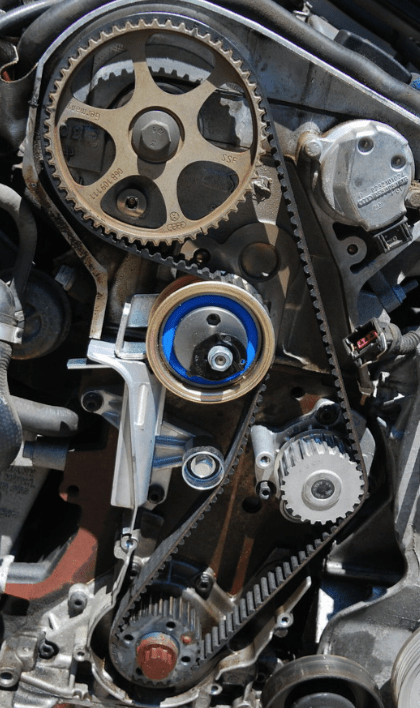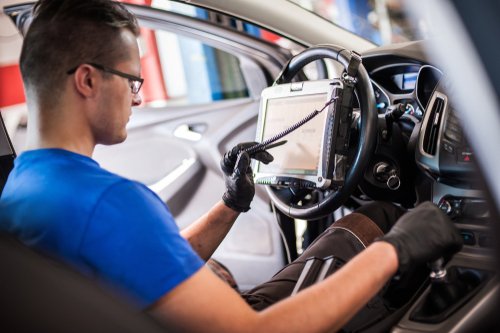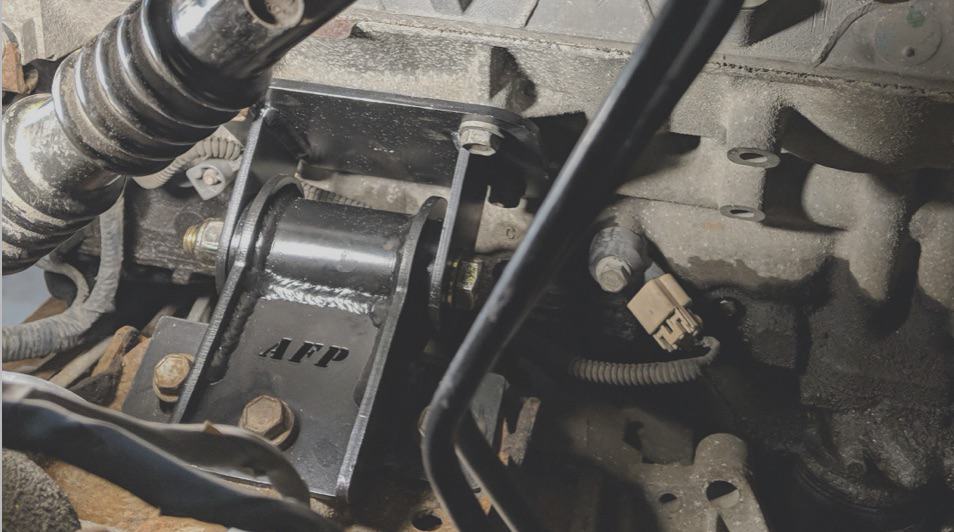Is your check engine light on? If you’re seeing the P0013 code pop up, don’t panic just yet. This little troublemaker is telling you there’s an issue with your camshaft position actuator circuit on Bank 1.
Sounds fancy, right?

Let’s break it down in plain English. The P0013 code indicates a problem with the system that controls the timing of your engine’s valves, specifically on the exhaust side of Bank 1. Think of it as your engine’s rhythm section getting out of sync.
When this happens, your car might start acting up, running rough, or burning more fuel than usual.
Key Takeaways
- P0013 indicates a camshaft timing issue that can affect engine performance
- This code can be triggered by various factors, from faulty valves to wiring problems
- Understanding the cause is crucial for proper diagnosis and repair of your vehicle
Understanding Trouble Codes
Decoding those pesky engine codes can be like solving a mystery. Let’s crack the case of P0013 and explore why your car’s computer is tattling on you.
P0013 Code Specifics
P0013 is a diagnostic trouble code that points to an issue with your “B” camshaft position actuator circuit on Bank 1. In plain English, it means your engine’s timing is off its rocker.
This code is your car’s way of saying, “Hey, something’s wonky with my exhaust camshaft!” It’s like your engine is trying to dance but can’t find the beat. Your car’s computer, being the clever little box it is, notices when the camshaft isn’t moving as it should.
When this happens, you might notice your engine running rougher than a cat in a bathtub. Your fuel economy might also take a nosedive, leaving your wallet feeling lighter than usual.
The Purpose of OBD-II

OBD-II, or On-Board Diagnostics II, is like having a tiny mechanic living in your dashboard. It’s a standardized system that keeps an eye on your car’s vital signs.
When something goes awry, OBD-II lights up your malfunction indicator lamp (MIL) faster than a Christmas tree. It’s not just there to annoy you – it’s actually trying to save you from costly repairs down the road.
This system monitors everything from your engine to your emissions. It’s like a gossipy neighbor, always ready to spill the beans on what’s happening under your hood.
When it spots trouble, it stores a code that mechanics can read to diagnose the issue.
Remember, these codes are just clues. They point you in the right direction, but it takes a bit of sleuthing (or a good mechanic) to solve the mystery completely.
Engine Anatomy and P0013

Understanding the relationship between engine components and the P0013 code is crucial for diagnosing and fixing this issue. Let’s dive into the nitty-gritty of how your engine’s anatomy plays a role in this pesky problem.
Role of the Camshaft Position
Your engine’s camshaft is like a conductor, orchestrating the opening and closing of valves with precision. The camshaft position sensor keeps tabs on this timing, feeding info to your Engine Control Module (ECM).
When the P0013 code pops up, it’s like your engine’s trying to tell you, “Hey, something’s off with my exhaust camshaft timing!” This can throw a wrench in your Variable Valve Timing (VVT) system.
VVT is your engine’s way of adapting to different driving conditions. It’s like having a Swiss Army knife for engine performance – versatile and efficient when working correctly.
Bank 1 and Its Significance
Now, let’s talk about Bank 1. It’s not a financial institution, folks! In engine speak, Bank 1 refers to the side of the engine with cylinder number one. It’s like the VIP section of your engine block.
When P0013 points to Bank 1, it’s singling out the exhaust camshaft on this side. Your ECM is saying, “Houston, we have a problem with the actuator circuit on Bank 1’s exhaust cam.”
This circuit controls the camshaft position actuator, which is crucial for adjusting valve timing. If it goes haywire, your engine might start running rough, like it’s had one too many oil cocktails.
Remember, a happy Bank 1 means a smooth-running engine. But when P0013 crashes the party, it can lead to poor fuel economy and performance that’s about as exciting as a flat tire.
Tracing the Root of the Issue

Finding the culprit behind the P0013 code can be like playing detective with your car. You’ll need to put on your sleuthing hat and follow the clues to uncover the mystery. Let’s dive into the nitty-gritty of tracking down this pesky problem.
Investigating the Circuit
First things first, you’ll want to give that wiring harness a good once-over. Look for any signs of damage, fraying, or loose connections. It’s amazing how often a little rodent decides your car’s wiring makes a tasty snack!
Next, grab your trusty digital volt ohm meter. You’ll use this to check for continuity and proper voltage in the circuit.
If you’re getting readings that look like your heart rate during a horror movie, you might have an open circuit on your hands.
Don’t forget to check the connectors too. Sometimes they can get a bit shy and decide not to make proper contact. A little cleaning and reconnecting might just do the trick.
Checking the Actuator and Connectors
Now it’s time to take a closer look at the star of our show – the camshaft position actuator. This little gadget is responsible for adjusting the timing of your engine’s valves.
If it’s not doing its job, your engine might sound more like a blender full of wrenches than a well-oiled machine.
Give the actuator a visual inspection. Is it covered in more oil than a deep-fried turkey? That could be a sign of internal issues. Check the electrical connectors too – they should be snug and corrosion-free.
Don’t forget about the actuator solenoid. This is the part that actually moves the actuator. If it’s stuck or not responding, your engine timing will be off, and that’s when the P0013 code decides to crash your party.
The Impact on Your Ride
When your car’s computer throws a P0013 code, it’s not just a pesky light on your dashboard. This little gremlin can wreak havoc on your daily commute and your wallet.
Symptoms of the P0013 Code
You might notice your car acting like it’s had one too many at the local auto bar.
Rough idling is often the first sign that something’s amiss. Your engine might shake and shudder like it’s doing the cha-cha at stoplights.
Stalling becomes your new unwanted driving companion. One minute you’re cruising along, the next you’re stranded on the roadside wondering if you forgot to feed your car its favorite premium fuel.
Performance issues? Oh, you bet! Your once peppy ride now accelerates with all the enthusiasm of a sloth on vacation. It’s like trying to win a drag race with a golf cart.
Performance and Efficiency Fallout
Remember when you used to brag about your fuel efficiency? Those days are gone, my friend.
With a faulty actuator solenoid, your engine timing goes haywire. It’s like your car’s internal clock is stuck in a different time zone.
Your fuel consumption skyrockets faster than a rodeo bull on Red Bull. You’ll be on a first-name basis with every gas station attendant in town.
Fixing the Glitch
Got a P0013 code lighting up your dash? Don’t worry, you’re not alone in this automotive adventure. Let’s roll up our sleeves and get that camshaft actuator back in line.
From Diagnosis to Solution
First things first, grab your trusty diagnostic scan tool. It’s like a doctor’s stethoscope for your car. Pull those codes and see what your four-wheeled patient is trying to tell you.
Next, pop the hood and take a peek at the oil control valve. This little gizmo controls the oil flow to your VVT solenoid.
If it’s clogged or faulty, your camshaft’s timing will be off faster than a teenager’s curfew.
Check the wiring too. Frayed wires can cause more trouble than a cat in a yarn factory.
If everything looks ship-shape, it might be time to replace the OCV. Remember, a little elbow grease now saves a lot of headaches later.
The Role of Preventative Maintenance
You know what they say: an ounce of prevention is worth a pound of cure. And boy, does that apply to your car!
Regular oil changes are your best friend.
Clean oil keeps your OCV and VVT solenoid happy, which in turn keeps your engine purring like a contented kitten.
Stick to those oil change intervals like glue.
Don’t forget to consult your factory service manual. It’s not just a doorstop, you know!
It’ll give you the lowdown on maintenance schedules tailored to your ride.
If all this sounds like Greek to you, don’t be afraid to call in the cavalry.
A good mechanic is worth their weight in gold (or at least in motor oil).
They’ve got the know-how to keep your car running smoother than a greased pig at a county fair.
Frequently Asked Questions
The P0013 code can be a tricky little bugger to deal with. Let’s dive into some common head-scratchers about this pesky problem and how you can tackle it.
What steps are involved in fixing the P0013 code on a Chevy Malibu?
First, you’ll want to check the oil level and quality. Low or dirty oil can cause the Variable Valve Timing (VVT) components to malfunction.
Next, inspect the electrical connections to the camshaft position actuator.
A loose or corroded connection could be the culprit.
If those checks come up clean, you might need to replace the camshaft position actuator or its solenoid.
Don’t forget to clear the code after repairs!
Can I safely drive my vehicle if I have a P0013 code appearing?
While you can probably limp your ride to the nearest shop, it’s not a great idea to keep driving with this code.
You might notice poor fuel economy, rough idling, or even stalling.
Your engine’s performance will suffer, and you could be doing more damage the longer you drive. It’s best to get it checked out ASAP.
What does the P0013 exhaust camshaft position actuator solenoid valve control circuit do?
This mouthful of a component controls the timing of your exhaust valves.
It’s part of the VVT system, which helps your engine run more efficiently at different speeds.
When it’s working right, it adjusts the camshaft position to optimize engine performance.
When it’s not, well, that’s when you get the P0013 code and a grumpy engine.
Where can I locate the exhaust camshaft position actuator circuit on my vehicle?
You’ll find this little troublemaker on the cylinder head, usually near the exhaust camshaft.
It’s typically on the rear or right side of the engine, depending on your vehicle’s layout.
Look for a small solenoid with electrical connections.
If you’re not sure, your vehicle’s repair manual can be a big help in pinpointing the exact location.
What are the common symptoms indicating a P0013 code has been triggered?
Your car might start acting like it’s had too much caffeine.
You could experience rough running, ignition issues, and poor fuel mileage.
The check engine light will likely be on, and you might notice a decrease in power or acceleration.
In some cases, you could even have trouble starting the engine.
How does a P0013 code differ from a P0010 code, and what does ‘Bank 1’ mean?
Think of P0013 and P0010 as fraternal twins. They’re related, but not identical.
P0013 deals with the exhaust camshaft, while P0010 is about the intake camshaft.
As for ‘Bank 1’, that’s mechanic-speak for the side of the engine that includes cylinder number one.
In most engines, it’s the side closest to the front of the vehicle.
